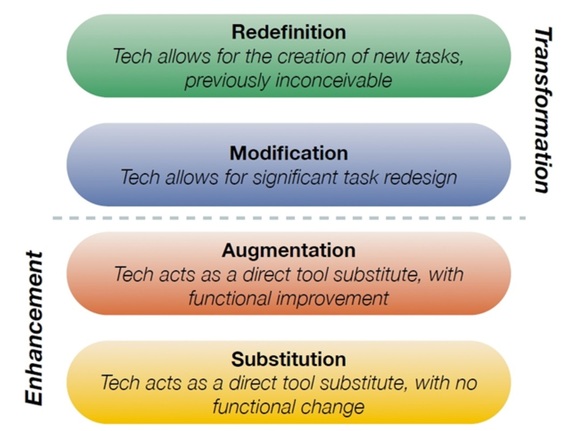An Introduction to the SAMR Model of Technology Integration

Before I get into the nitty-gritty of this week's tech blog, I want to say Happy Anniversary to my wife, Jessica. She has been very supportive of me in my new role, and for that I am very thankful. I decided to create her a little 'techy' gift, that I think all will enjoy. See it in this week's "Tech This Out".
This week, I have spent some time reading about the SAMR model, developed by Dr. Rueben Puentedura. It is a way to self-assess your integration of technology into your classroom, and works similar to a ladder. There are 4 stages: substitution, augmentation, modification, and redefinition. Dr. Puentedura suggests that the most effective integration of technology happens in the modification and redefinition stages, also known as the transformation stages. Let's look at what each stage would look like.
Substitution
In this stage, technology does not enhance the learning process, but instead replaces an existing tool or model. For example: Students are asked to write an essay with paper and pencil. In the substitution phase, they would use a word processor to type their essay. The task is the same, and there is no added benefit to using the computer.
When using technology in your classroom, you want to make sure that you are using it with a set outcome in mind, and not "just to use technology." In some circumstances, technology can get in the way when there is a simpler, non-tech way of obtaining the same outcome.
Augmentation
The augmentation stage is similar to the substitution phase, but with an added benefit involved for doing the task with the use of technology. For Example: Using a word processor to type an essay is substitution, but using the features such as changing font, spell-check, and alignment tools all are 'augmenting' the original task.
Augmentation improves the product, and possibly the means by which the product is attained. However, it does not always result in higher-level learning.
Just to check if you are reading this, the first 2 people who email me the word "SAMR" will receive a prize (past winners are not eligible).
Modification
This is the first stage that really starts to change how students learn. Dr. Puentedura says that this is when the classroom "Transforms".
The modification stage uses technology to change the outcome to one of higher level thinking (and learning). For example: Take the same essay assignment. Students could type the essay on Google docs, and then share with their peers and leave comments/feedback for each essay. The assignment has now been modified and the students are now evaluating and working collaboratively.
Redefinition
At the top stage, students would be asked to do a totally new task, that would be previously inconceivable without the use of technology. An example in this stage would be to take the concept of the essay, and have students create a video with narration, music, etc. Then, students can publish their work and provide feedback in real-time.
When looking at your own lessons, and think of how you could incorporate technology to create new outcomes that would not be possible without technology. If you want some help on ways to take your students further with the aid of technology, book a time with me and I would be glad to help you meet your desired outcomes.
Thanks for reading, and have a great week! Don't forget to check out the video below :)
Hey, Tech This Out!...
Name: Plotagon
Type: Ipad App (maybe android too?)
Subject: Any
Grade: Grade 3+
What it does: You build your characters, you choose the scene, and you enter plot and dialogue. Plotagon turns it into an animated cartoon.
My Take: This was one of the most fun apps I have played around with yet. There are some MAJOR limitations on what it can do (all people are the same height, weight, etc./Only can have 2 people in the clip at a time/Cannot add props or visual text/Only on Ipad). However, if you are wanting an alternative to a quick skit, this could be your tool. The ability to customize each character, their voice, their mood/actions, etc. are what make this a useful app. It also creates a pretty professional looking product that makes people think you spent hours when really it took minutes.
*Events in the video may or may not have really happened the way they are portrayed* Also, thank you Joe Stellmacher for unknowingly co-starring.

Bryant, it says I can't watch your fabulous Plotagon to your wife. It says that it is restricted.
ReplyDelete